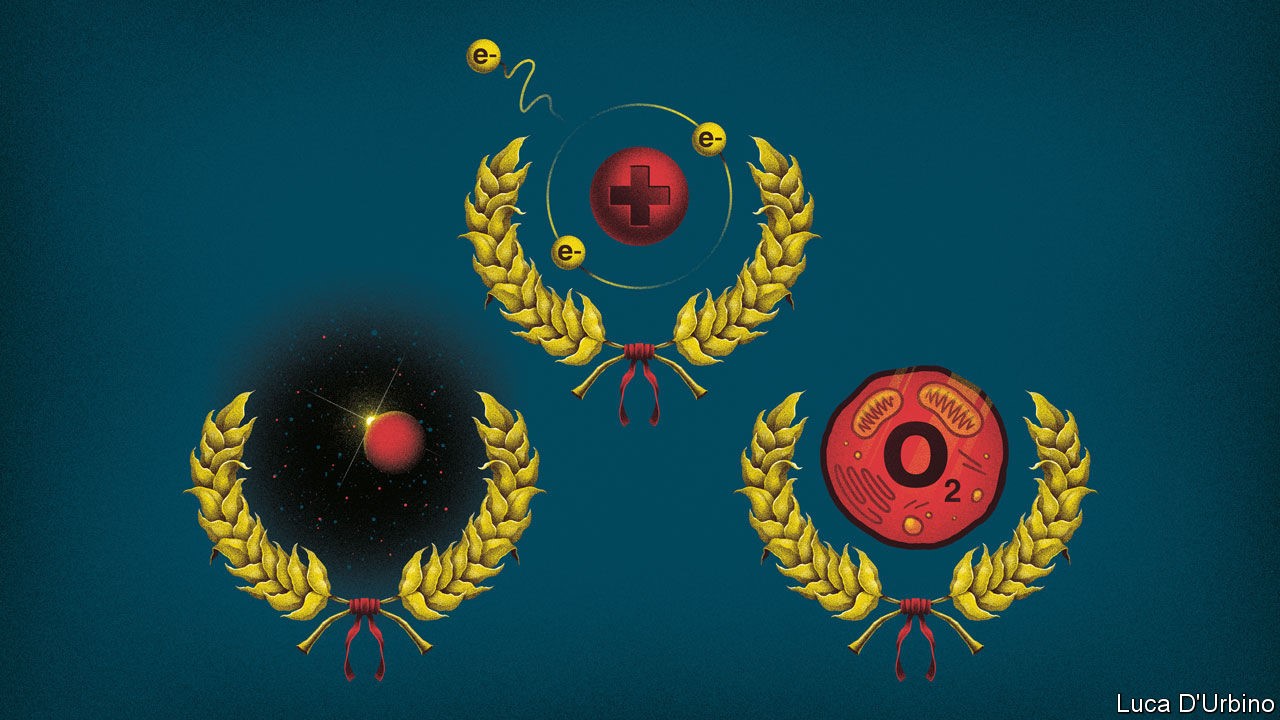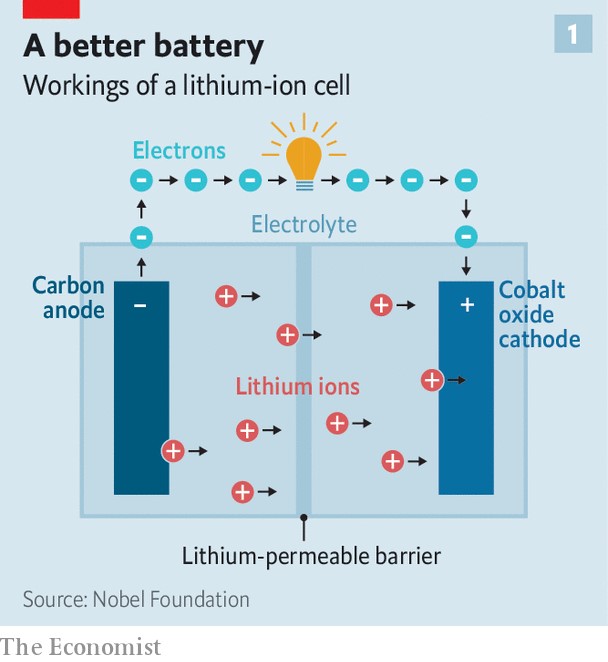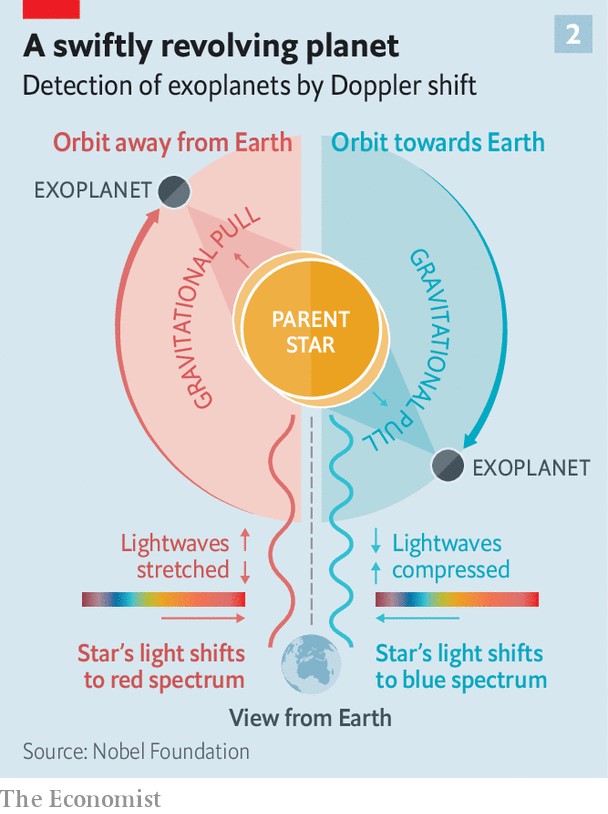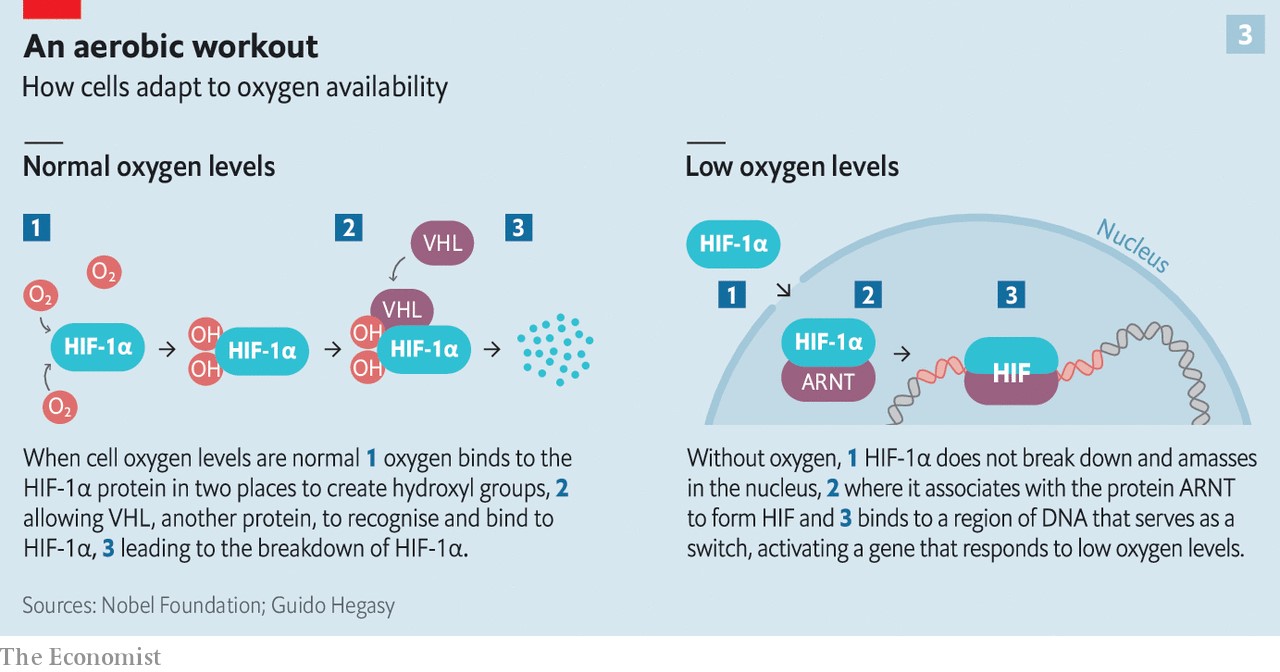今年的諾貝爾獎頒發給比較親近人們生活,或是已經打入人類日常生活常識的理論貢獻者。化學獎頒給訂定規格化的鋰電池(嚴格的說是鋰離子電池),物理學獎頒給闡明觀察星球運行光譜時,為何須考慮都卜勒效應所影響的觀測結果(否則觀測者會誤以為行星邊運行邊燒熔),生理醫學獎頒給找到生命體內共通蛋白質,作為協助細胞有效率利用氧氣(分為一般氧氣充足和不足情形討論),的細胞生物學者們。
首先看到的是化學獎。化學獎指出了商業化推動科學發現和科技進步的重要。經濟學者雜誌花了一小段,稍事說明鋰的特性,就筆者所知像筆者在就讀長庚大學醫學系讀書時,醫院裡的楊庸一醫師,以鋰鹽可治阿茲海墨症等腦神經遲緩,筆者前幾月在台北的鴻海三創賣電腦時,宏碁ACER的最先進筆電,當屬鎂鋰合金上蓋的Swift 7,很輕薄和強度、耐震度遠優於從2010年底,SONY SA23以來的鋁鎂合金。而鋰電池的應用也非常的廣,從電子產品,如智慧手機、隨身聽、醫療用、可充電式的電子設備,現在應用最廣的筆記型電腦和行動電源,若在主機版電路邏輯是電器產品,可以使用「鋰離子電池芯」來作充電單元。除了一般而言的一次式「鋰電池」,還有作成「鋰離子聚合物」的電池,是SONY在1999年量產,用在Ericsson T28行動電話。現在的iPHONE就是使用鋰聚合物電池,較鋰電池來說可重覆充電,雖然容量受限於比條狀鋰電池稍高的成本,但安全性高。
這次化學獎得主三位,就是說明了商業化推進科技的演進,而作出對人類生活有重大貢獻。Exxon埃索石油公司(就是美國總統川普的第一任國務卿任職過執行長的公司),Stanley Whittingham是「鋰離子」電池的原作者,為了研究超導體的特性,某天發現原子和原子間的間隙,離子有可能滲入其中,於是形成「夾層」(intercalation),而原有物質的特性就隨著改變了。他最初發現這個夾層附隨於二硫化鈦,然後用鋰離子滲入。在滲入的過程中,會放出能量,也就是說有電能的形成,似乎可以拿來使用。於是設計金屬鋰條狀物為陽極(anode),而二硫化鈦為陰極(cathode)。鋰電子從鋰原子「逸散」後,透過溶液及設計的「通透膜」,吸附上陰極的二硫化鈦。如果施以電源,給予電能,這時一整個系統就是「電器」,電子游回鋰原子端,就是充電,可作為放電的準備,我們說電化電池的這個情形有電位能。
John Goodenough的得獎是因為,在這個模式誕生後,因為Exxon的營運受到石油價格暴跌,而無法進一步開發,John把陰極改成氧化亞鈷,並且有兩倍電壓。另一位Akira Yoshino吉野彰先生,則希望大量生產,但宥於鋰的高昂價格,他從有數億蕨類至數千萬年前恐龍化石等長年受地形高壓,所形成的石油次級產品中得到碳混合液有鋰離子,並且就此作成新模型的碳棒陽極,有了好棒棒的安全,電池耐用壽命和單次放電續航力延伸,並且可以大量化作成小型商業包裝出售,由索尼SONY,世界電池的專家在1991年發售第一批條狀電池,並規格化延用至今。今天恐龍還在台北賣電腦,作抽成的Gay沒有r,真是不可思議的一件事。
接著寫到物理學獎。獎金的一半由Michael Mayor和Didier Queloz兩位獲得,和另一位James Feebles對分。因為看到被觀察的上千顆行星,也有像他們兩位一樣的問題,就是行星不可能自燃如光譜儀讀到的攝氏上千度這麼高溫。如果考慮都卜勒效應,亦即利用發出的波長恆定λ=v/f,同作微分,v和f的差值為相等(基準點者和比較點者的頻率)的推理(須考慮向量方向):(v觀測點基準-v介質)/(f想觀測的實際值)=(v被觀測物-v介質)/(f被觀測物)。(ps 筆者九科全部超頂標,三個類組只有兩個系填不到時,就是沒有背記f會等於什麼,分子要負正,分母要正負那種,筆者高一導師羅安淇老師的爸爸羅芳晁老師發明...等物理化學公式考到的)剛剛上面的公式,的確是Queloz本人發明的想法喔,Queloz認識筆者高三的物理吳文政老師,上課就是使用這個想法,只有十幾分鐘就說完都卜勒公式和聲波的全部內容。
拉回來講,也就是要考慮地球看行星的相對速度,及行星是否有母恆星,而母恆星及行星之間的引力是否又構成使光譜顯示了「錯誤」的數值,也就是找修正項推演回去,求得逼真數值。透過都卜勒頻移(Doppler Shift),觀察行星亮度週期,1995年在法國普羅旺斯天文台,確認了太陽系以外的第一個行星「飛馬座51b」,大部份是氣體,並且約略和木星同大小。就此改觀人類對於宇宙的認知,並一度引起話題,是否有地球以外的生命存在,若有則其中一個應該是51b或其他類似型態。迄今三、四千顆被命名的行星,均是照此公設模式推理作記載的。
另外一名有得獎的是James Peebles,是在普林斯頓大學講學的老師。普林斯頓大學就是美國的師範大學。除了專門的學術研究,就是專辦全球升學考試的教育與測驗中心(ETS)聞名於世。Dr Peebles是讓宇宙學從幾篇論文的猜想,進一步成為一門具理論邏輯,又有豐富資料佐證的獨立學門。1964年可說是宇宙學元年,太空學者和太空人,於是年發現了最遠波長可追朔自130億年前所發出,和Peebles年輕時的推論符合,這震驚了全世界。Peebles的「微波分析」研究是迄今,談論宇宙生成時,最具說服力及理論性的猜測,就是嶼宙初始狀態,應該是「蜷」在一起的,高壓高溫,重力場極大的「小點點」。他是透過現今的「銀河」和「銀河星塵」狀態推理來的。
最後來看到生理醫學獎,今年頒給了細胞分子學者,有三位學者闡明了大部份現存物種的細胞內,如何透過特定蛋白質,作偵測與調節氧氣量 - 無論是充氧或缺氧環境中 - 以滿足或應付日常生理活動所需。這三位學者是William Kaelin, Sir Peter Ratcliffe and Gregg Semenza。Semenza是找出並命名關鍵蛋白質複合物hypoxia-inducible factor (HIF),由HIF-1α和ARNT兩個蛋白質單元組成。他研究運動員高地訓練時,紅血球生成素的變化。並以微觀視之,找出調控這個紅血球生成素的,附在DNA上的基因,粗略有50個鹼基片段。如果有氧氣接近,氧氣在細胞液內的氫氧根(OH¯),和HIF-1α作結合(叫作:脯胺醯基羥化作用(prolyl-hydroxylation)),這時有個蛋白質叫作VHL,是Dr Kaelin所發現。順帶一提,VHL是抑瘤基因所生成,人體內該基因若發生突變而無法抑瘤,則說該患者患有von Hippel-Lindau disease,好發於腎臟和眼睛。Sir Peter 則是完備的以實證提出了這驚動世界,蛋白質和細胞充氧或厭氧時,兩方面自處之道的機制:正常氧氣充足情形下,VHL和HIF-1α,及氫氧根,三者結合後發生「降解」(degradtion),也就是說,氧氣多的話,HIF-1α就會因如此之反應變少,氫氧根扮演「標記」,引誘VHL前來,作蛋白質「降解」變成碎片。另外ARNT的話,文中沒有多提,是畫在圖片的右側,就是如果分離的ARNT遇到缺氧環境時,因為氫氧基也變少,會和HIF-1α結合回來成HIF,而非和VHL結合,並且跑去結合的是DNA上會反應出缺氧的基因,以轉錄轉譯成蛋白質提供訊號給人體相關部位,使人體感覺缺氧(比如不由自主地喘一下腳軟了。鴻海三創的冷氣不錯通風,站一整天都精神抖擻,如果去新光華商場不到半小時身上應該一堆沒分裂的HIF)。
每年都帶著懷舊的心情來看最新受世人肯定的科學科技,和理論內容,又說是朝聖一次眷戀而不忍離去,不知不覺又是一年秋去冬來,而距筆者有系統地認識這個獎(包括經濟學獎)已經20多年過去了。
The 2019 Nobel prizes
Batteries, exoplanets, cosmology and cell biology win Nobel laurels
And humanity is enriched in both body and spirit

Print edition | Science and technology
Oct 12th 2019
ALFRED NOBEL’S will states that the annual prizes bearing his name should be given to those who “have conferred the greatest benefit to mankind”. The science awards, though, have a tendency to end up in the hands of those who have made esoteric, if profound, advances rather than practical ones. Not so with this year’s prize in chemistry. Three researchers—two from America and one from Japan—have been rewarded for their work in developing the lithium-ion battery.
Lithium-ion batteries have transformed society because they are lightweight and rechargeable. They have therefore become ubiquitous in everything from mobile phones, tablets and laptops to electric cars. They could also, in the future, become important in storing the intermittently available energy produced by renewable sources such as wind and solar power, as the world attempts to move away from fossil fuels.
Lithium is the lightest metal in the periodic table (it will float on water, though not for long, because it is also one of the most reactive and turns rapidly into lithium hydroxide), and its atoms have three electrons. Two are tightly bound to its nucleus but the third is easily dislodged to create a positively charged lithium ion.
The beginnings of making a battery out of lithium and its ions came in the 1970s, when the world was gripped by the oil crisis. Exxon, a large oil company, was interested in developing sources of energy that did not involve petroleum and one of this year’s laureates, Stanley Whittingham, was working at the time in the firm’s research division. He was investigating potential superconductors. Specifically, he was interested in solid materials that contained atom-sized spaces. When ions entered these spaces—a phenomenon called intercalation—some of the properties of the solid material, such as its conductivity, would be changed.

Dr Whittingham discovered that when lithium ions intercalate with a substance called titanium disulphide, the interaction stores a useful amount of energy. Employing metallic lithium as an anode and titanium disulphide as a cathode, he built a rechargeable battery cell that worked at room temperature. In it, lithium at the anode is ionised and the ions thus produced then move through an intervening electrolyte and into the spaces in the titanium disulphide cathode. The liberated electrons, meanwhile, traverse an external circuit to create an electric current that can be used to do work. During its recharge cycle, the external current is reversed and the lithium ions move back through the electrolyte in response (see diagram 1).
At first Exxon thought the battery had great potential and decided to commercialise it. But when oil prices fell back the company lost interest. It was about then that the second of this year’s chemistry laureates, John Goodenough, who was working at Oxford University, came across the idea and decided to try to improve it. In 1980 he found that, by replacing the titanium disulphide in the cathode with cobalt oxide, he could double the output voltage.
Akira Yoshino, the third laureate, took Dr Goodenough’s idea and transformed it into the modern battery that sits inside the world’s computers and phones. In the 1980s he was working at the Asahi Kasei Corporation, in Japan, at a moment when electronics companies were becoming increasingly interested in lightweight batteries that could power new electronic devices such as video cameras and cordless telephones. Dr Yoshino was happy with Dr Goodenough’s cathode, but felt that the anode needed redesigning.
Instead of lithium, he tried various carbon-based materials that might hold lithium ions. He found success with petroleum coke, a by-product of the fossil-fuel industry. This, he discovered, could hold such ions in abundance. His design was not only safer than using a pure lithium anode (lithium has a distressing tendency to catch fire), but longer lasting, too. In Dr Yoshino’s version of the battery, both anode and cathode have a long life because they are not damaged by chemical reactions as the battery is used or recharged. By 1991, the first lithium-ion battery based on Dr Yoshino’s design had been commercialised by Sony, an electronics company.
Speaking at a press conference shortly after being awarded the prize, Dr Yoshino said he had pursued his research in the 1980s purely to satisfy his own curiosity, without much thought as to whether or not his inventions would one day be useful. Given the lithium-ion battery’s subsequent (and continuing) importance, Dr Yoshino’s curiosity ended up fulfilling Nobel’s will to the letter.
Cosmic thoughts
The physics prize was split two ways, but both halves went for discoveries beyond Earth. One was for a finding that is, by astronomical standards, quite close by—a planet going around a star a mere 50 light-years distant. The other was for an overview of the entire universe.
In October 1995 Michel Mayor and Didier Queloz, a pair of astronomers then working at the University of Geneva, presented a paper at a scientific conference in Florence. A few months earlier, they had discovered a planet beyond the solar system. It was a gaseous ball twice the size of Jupiter and was going around a star called 51 Pegasi, at a distance of about 8m kilometres—a twentieth of the distance from Earth to the sun. As a consequence of this proximity it orbited 51 Pegasi once every four terrestrial days and had a surface temperature in excess of 1,000°C. The discovery was a puzzle for astronomers. Until then they had thought that such large, Jupiter-like planets could form only far away from their host stars.
That discovery of 51 Pegasi b, as this planet is now known, launched the field of exoplanet astronomy. To date, astronomers have found almost 4,000 other such planets—and the wide variety of sizes, orbits and compositions of these objects continues to surprise researchers, who have yet to come up with a comprehensive physical theory of how planetary systems form.

Since planets do not shine by themselves, astronomers needed to develop special methods to find them. The one Dr Mayor and Dr Queloz used relies on a phenomenon called the Doppler effect. As a planet orbits its star, that star will also move slightly, as it is pulled around by the gravity of the planet (see diagram 2). This will cause the frequency of the starlight arriving at Earth to oscillate (that is, the star will change colour slightly) in the same way that the frequency of an ambulance siren shifts as the vehicle passes by. Nowadays a second approach, which measures the dip in starlight as a planet passes across its disc, is more common. But the Doppler-shift method, as employed by Dr Mayor and Dr Queloz, is still used as well.
The half-prize for the overview of the universe went to James Peebles of Princeton University, who has spent decades developing a theoretical framework to describe how the cosmos evolved from the Big Bang 13.7bn years ago to the state it finds itself in today. According to Sweden’s Royal Academy of Science, which awards the physics prize, Dr Peebles was the person who, in the 1960s, shifted cosmology from speculation to a rigorous discipline.
Until the first decades of the 20th century, astronomers had assumed the universe to be stationary and eternal. This was shown to be incorrect in the 1920s, with the discovery that all galaxies are moving away from each other. In other words, the universe is expanding. Rewind the clock and this means that, at the start of time, now called the Big Bang, the universe would have been incredibly small, hot and dense.
Around 400,000 years after the Big Bang it had expanded and cooled enough for light to travel through space unimpeded. Astronomers can detect the glow of that first light today but, because its wavelength has been stretched by 13bn years of the expansion of space, it manifests itself not as light but as a glow of microwave radiation that fills the entire sky. This cosmic microwave background was discovered, by accident, in 1964 by radio astronomers, who used earlier theoretical work by Dr Peebles to explain their discovery. Dr Peebles also showed that tiny fluctuations in the temperature of the microwave background were crucial to understanding how matter would later clump together to form galaxies and galaxy clusters.
Since the early 1990s, space-based observatories have built up increasingly precise portraits of the cosmic microwave background and, true to Dr Peebles’s predictions, these show that temperature variations of just one hundred-thousandth of a degree map onto the observed distribution of matter and energy in the universe.
Rewarding cosmic shifts in understanding might seem to be a normal day’s work for those who give out the Nobel prizes. But Martin Rees, Britain’s Astronomer Royal, sees something new in this year’s awards in physics. The award to Dr Peebles, he says, will be welcomed by physicists as recognition of a lifetime of sustained contributions and insights by an acknowledged intellectual leader, rather than a one-off achievement.
Such lifetime-achievement awards are more usually associated with the Oscars than the Nobels. But that is not inappropriate. In many ways the Nobel prizes are a Swedish version of the Oscars—with seriousness substituted for superfice, substance for style, and genuine modesty among the winners for the false sort.
The oxygen of publicity
Those qualities were certainly to the fore in the award of the prize for physiology or medicine. This shone a spotlight onto work that, though of crucial importance in understanding how human bodies work, is—unlike batteries, exoplanets and matters cosmological—almost invisible to the outside world. Yet together William Kaelin, Sir Peter Ratcliffe and Gregg Semenza have answered an important question: how cells detect and adjust to the level of oxygen available to fuel their activities.
The crucial molecule in the system that matches cell physiology to oxygen availability is a protein complex called hypoxia-inducible factor (HIF). HIF was discovered and named by Dr Semenza, who works at Johns Hopkins University, in Baltimore. In the 1990s Dr Semenza was studying erythropoiesis, the process that generates red blood corpuscles. These are the cells that carry oxygen in the bloodstream, and their number depends on how much oxygen there is around. Professional athletes, for example, often train at high altitude, where the thin air means oxygen is scarce, in order to grow extra red blood cells that will assist their respiration when they compete nearer to sea level.
The hormone that triggers erythropoiesis is called erythropoietin, or EPO. Indeed EPO, which is manufactured as a drug to help those with anaemia, is also used illegally by some athletes to boost their red-cell count without the trouble of visiting high altitudes. (In cycling, for example, it is notorious.) Dr Semenza was looking at a stretch of DNA, located within the gene that encodes EPO, which switches that gene on and off. In doing so he discovered HIF, a protein complex that, by attaching to or detaching from the DNA switch (see diagram 3), does the switch-throwing. Since Dr Semenza’s discovery, 300 genes similarly regulated by HIF have been found.

Dr Kaelin’s contribution was to discover a further protein, VHL, that regulates how levels of HIF in a cell are controlled by oxygen levels. HIF actually consists of two proteins, now known as HIF-1 alpha and ARNT. ARNT is always present in a cell, but the level of HIF-1 alpha depends on the amount of oxygen present. More oxygen means less HIF-1 alpha. That, in turn, means less of the HIF complex. Genes like that for EPO, which rely on HIF to switch them on, thus remain inactive.
Dr Kaelin, who works at the Dana-Farber Cancer Institute in Boston, was studying an inherited genetic illness called von Hippel-Lindau’s disease which greatly increases the likelihood of certain tumours (sometimes benign, sometimes malignant, affecting organs including the kidneys and eyes) developing. VHL is the protein encoded by the gene that, when mutated and thus non-functional, causes von Hippel-Lindau’s disease. Dr Kaelin showed that a non-functional VHL-encoding gene caused many HIF-regulated genes to go into overdrive—which is the underlying cause of the tumours in question.
The pieces of the puzzle were then put together by Sir Peter, who works at Oxford University. He showed that VHL and HIF-1 alpha interact with one another, and that this interaction, which incorporates molecules called hydroxyl groups into the mix, makes HIF-1 alpha susceptible to degradation in the presence of oxygen. The degradation is not direct. It is not that HIF-1 alpha is being oxidised, and thus destroyed. Rather, the hydroxyl groups, which are created by a reaction between HIF-1 alpha and oxygen, mark it for destruction by a cell’s protein-degrading machinery.
The practical upshot of all this is a better understanding of the biology underlying anaemia, tumours such as those encouraged by von Hippel-Lindau’s disease and many other oxygen-sensitive processes. These include the healing of wounds, the growth of blood vessels (one reason for the link with tumours, since these need extra blood vessels in order to grow), and the likelihood of heart attacks and strokes. With luck, drugs tailored to regulate the actions of the various HIF-controlled genes involved will be able to promote or prevent these phenomena—and, albeit more quietly than is the case for lithium-ion batteries, the intention of Nobel’s will will have been fulfilled in this case, too.■
Listen to our discussion about the Nobel prizes at economist.com/nobelprizes2019
This article appeared in the Science and technology section of the print edition under the headline "Supercharged!"
風傳媒報導的文章:(只附一張圖,https://www.storm.mg/article/1804182)
2019年諾貝爾物理學獎》改變人類對宇宙演化認知、發現首顆太陽系外行星 加拿大、瑞士3學者同獲獎
2019-10-08 18:07
18122 人氣
2019年諾貝爾物理學獎8日揭曉,由加拿大學者皮博斯、瑞士天文學家麥耶與奎洛茲共同獲得,皮博斯得獎原因是「改變人類對宇宙演化、地球在宇宙中地位的認知」,麥耶與奎洛茲則是共同發現了第一顆太陽系外行星「飛馬座51b」,三人共同獲得900萬瑞典克朗(約新台幣2830萬元)獎金。
瑞典皇家科學院(Kungliga Vetenskapsakademien)說,今年的得獎者改變了我們對宇宙的看法。皮布爾斯的理論幫助於我們理解宇宙在大爆炸之後如何演變,麥耶跟奎洛茲探索了太陽系外的世界,擴展人類對行星的瞭解。三位科學家的發現,永遠改變了我們對於世界的概念
從「大霹靂」到「暗物質」的宇宙理論
瑞典皇家科學院秘書長韓森(Göran K. Hansson)指出,第一位得主皮博斯(James Peebles)從1960年代開始發展的宇宙學理論框架,讓宇宙學從單純推測成為真正的科學,已是當代科學理解宇宙的共通基礎。現年84歲的皮博斯持有加拿大與美國雙重國籍,現為美國普林斯頓大學(Princeton University)教授,在大霹靂(Big Bang)、宇宙微波背景輻射(CMBR)、暗物質(dark matter)、暗能量(dark energy)都有貢獻。
宇宙學是研究宇宙起源、演化及結構的科學。皮博斯是其中「結構形成」(structure formation )理論的先驅,探討星系(galaxy)、星系團(galaxy cluster)等宇宙大尺度結構。皇家科學院指出,大霹靂模型描述宇宙生成的最初樣態,約在140億年前,宇宙出現充滿高熱的大爆炸後便開始擴張,變得越來越大也越來越冷。40萬年後,宇宙變得具有穿透性,讓光線得以穿梭,許多古老祕密就藏在這些輻射線之中,而皮博斯發展的理論工具與演算法,能夠解譯這些宇宙初生存留至今的遠古密碼,並發現新的物理進程。
皮博斯研究中所展示的宇宙,只有5%內容是已知的,包括恆星、行星、萬物與人類。但還有95%屬於未知領域,是由暗物質與暗能量所組成,仍是現代物理學的謎題與挑戰。皮博斯的三本著作《物理宇宙學》(Physical Cosmology,1971)、《宇宙的大尺度結構》(Large Scale Structure of the Universe,,1980)以及《物理宇宙學原理》(Principles of Physical Cosmology,1993)如今都是該領域必讀教科書。他將一人獨得獎金的1/2。
發現第一顆太陽系外行星
麥耶(Michel Mayor)與奎洛茲(Didier Queloz)在1995年10月發現了天文史上第一顆太陽系外行星(exoplanet),這顆名為「飛馬座51b」(51 Pegasi b)的行星繞行一顆類似太陽的恆星,從根本上改變了科學界對宇宙的認知。皇家科學院表示,麥耶與奎洛茲1995年法國普羅旺斯天文台觀測到「飛馬座51b」,這顆行星身處太陽系之外、銀河系之內,這顆充滿氣體的行星約跟太陽系內最大的木星體積相仿,引發了天文學革命。
2019年諾貝爾物理學獎得主麥耶與奎洛茲,1995年10月在飛馬座恆星「51 Pegasi」發現人類所知的第一顆太陽系外行星「51 Pegasi b」(NobelPrize.org)
科學院稱,隨著科學家陸續又在銀河系發現4000多顆系外行星,各自擁有難以置信的大小、型態與軌道,都挑戰了人類對星系的觀念,迫使科學家修改行星產生的根源物理理論。隨著尋找太陽系外行星計畫的推展,人類最終也將會接觸到一道永恆疑問的解答,就是「宇宙是否存在其他生命」。
麥耶現年77歲,為瑞士日內瓦大學(University of Geneva)教授;奎洛茲現年53歲,為日內瓦大學、英國劍橋大學(University of Cambridge)教授,麥耶與奎洛茲兩人將各得1/4獎金。
2019年諾貝爾物理學獎得主、瑞士天文學家麥耶。(AP)
物理學獎知多少
2018年的物理學獎由美國科學家艾許金(Arthur Ashkin)、法國科學家穆胡(Gérard Mourou)、加拿大科學家史崔克蘭(Donna Strickland)3人共獲殊榮,得獎原因是這3位物理學家「在雷射物理學領域獲至突破性發明」。
諾貝爾物理學獎1901年首度頒發,雖有6年因為無適當人選或遇到戰爭而從缺,但頒發113屆仍是諾貝爾6大獎項之最。物理學獎迄今共有212位得主,其中發明電晶體的美國學者巴丁(John Bardeen)在1956年、1972年2度獲獎,至今無人能及。
物理學獎是性別最不均衡的諾貝爾獎項之一(僅次於經濟學獎),212位得主之中只有3位女性,分別是1903年的波蘭學者居禮夫人(Marie Curie,另在1911年拿下化學獎)、1963年的德國學者格佩特─梅耶(Maria Goeppert-Mayer)、2018年的加拿大學者史崔克蘭(Donna Strickland)。瑞典核子物理學家邁特納(Lise Meitner)與英國天體物理學家貝爾─伯奈爾(Jocelyn Bell-Burnell),是史上最著名的諾貝爾物理學獎遺珠。
物理學獎也是歷來最多華人得主的諾貝爾獎項,包括李政道、楊振寧(1957年共同獲獎)、丁肇中(1976年)、朱棣文(1997年)、崔琦(1998年)和高錕(2009年),其中高錕已在2018年過世。
※諾貝爾生理醫學獎的討論文章,由台大科學教育發展中心的老師所寫:(https://case.ntu.edu.tw/blog/?p=34521)
【2019 年諾貝爾生醫獎】一窺細胞如何「氧」尊處優

撰文|駱宛琳
每當十月一到,大家無不睜大眼睛等著新一年度的諾貝爾奬各個獎落誰家。禮拜一甫開出的諾貝爾生醫獎三位得主,你猜到了嗎?
今年的諾貝爾生醫獎,頒給了研究缺氧狀態下,細胞如何因應調節的生理機制;分別是為位於美國波士頓Dana-Farber Cancer Institute 的William Kaelin博士,身在巴爾的摩Johns Hopkins University 的Gregg Semenza博士,還有英國牛津Francis Crick Institute 的PeterRatcliffe博士。這研究或許不在所有人的得獎超級大熱門名單上,但卻絕對眾望所歸。
你如果看過Peter Thiel與 Blake Masters所著的《從 0到 1》,便知道任何一件事要從零做到一有多不簡單。而這三位科學家,不僅是成功地從零做到了一,更是在跨越出了那一大步之後,不論是自己實驗室的後續研究也好,或是啟發其他科學家的靈感也罷,讓缺氧環境的相關生理反應與調節,一路做到成千上萬、數不勝數。他們三人所一同開疆闢土、成就奠基的缺氧環境研究,對於各種細胞、各種疾病模式,皆影響深遠。事實上,這三位科學家在2016 年的時候,也一同獲頒有「諾貝爾前哨站」之稱的Lasker Award 殊榮。
那,這三位科學家是如何打開缺氧環境下的未知秘密呢?這故事,可是能夠一路追溯回九零年代。
細胞以「氧」為天:有「氧」能使細胞推磨,缺氧自是萬萬不能。但細胞如何知道周遭環境,是有氧還是無氧呢?
在當時,科學研究的主力都放在心臟、肺臟、與血液循環系統的構造與功能上。雖然對於這些臟器之於體內氧濃度恆定的調節維持相關研究,是多有成果,但這些假說與數據,都泰半侷限在以能量代謝反應為主的視角,卻不是以氧氣濃度為主角而看出去的視野。到底細胞自己,要如何感受到外在微環境裡的氧氣濃度,細胞自己又該如何決定一但有缺氧的狀況發生,該如何因應呢?
最早在1930 年代左右時,科學家就觀察到鈷中毒的患者,常常伴隨著一個臨床徵狀上的稀客:紅血球增多、增生。科學家很快就意識到,鈷鐵定是模仿了缺氧所能夠誘發的生理反應:製造紅血球生成素(erythropoietin,常簡稱為EPO)。但是,鈷既非主要代謝產物、廢物、毒物,可見,個體內紅血球生成素的產製,必定和體內氧氣濃度感測器是綁在一條船上的;而當個體鈷中毒的時候,不知怎地影響到了氧氣濃度感測器的迴路。
後來,更多的研究讓紅血球生成素與氧氣濃度的改變,成為定論。當氧氣濃度改變的時候,紅血球生成素的表現會增加,進而促進紅血球的生成。不過,要調節紅血球生成素的製造量,這可是很挑地方、也挑細胞的。製造主力之一是在腎臟,而Semenza博士與Ratcliffe博士所專注的肝臟細胞,也是另一處製造主力。但Ratcliffe博士實驗室很快地便發現,雖然製造紅血球生成素的細胞似乎得有特殊規格,但氧氣濃度感測器卻是各個細胞都裝上了一個。而Semenza博士更是第一個揭開了這個氧氣濃度感測器的神秘面紗:HIF (hypoxia-inducible factor)蛋白。這兩個團隊,找到在紅血球生成素基因上,有一段長約五十個鹼基的片段,和氧氣濃度的感測極有關係,而且能夠結合上一個特殊的轉錄因子,也就是HIF 是也。
他們和其他實驗室團隊也接著發現,HIF 蛋白並不是形單影隻,HIF 蛋白實際上是由兩個不同的、各自能和DNA 結合的轉錄因子所組成,是為HIF-1α 與HIF-1β。而HIF-1α 是能夠感測氧氣濃度的那個感應器。仔細研究之後,發現這兩個蛋白質的職責除了每個細胞都想管,還同時管很多基因。Semenza博士曾經表示,如果真要概括出一組數字的話,大概有百分之五的人類基因,都能夠受到這缺氧機制的調控。當然,是哪些基因受到調控,自然也得論細胞而自處了。但廣從細胞生長、分裂、存活,甚至是細胞移動,都可以受到HIF-1 的牽制。
HIF-1 的重要性也是從個體還在胚胎時期時就已經確立。如果在實驗小鼠模型上,把HIF-1α 的基因給剔除掉,那在實驗小鼠孕期第十天左右,胚胎就會停止發育了。這些小鼠胚胎,會因為剔除掉HIF-1α 基因而導致血管、心臟發育不全,可能是因為在缺少HIF-1α 基因的狀態下,血管無法正常形成。後來,更有其他科學家研究發現,胎盤要和子宮內層形成完整的血管網絡,也是需要HIF-1α 的正常運作。
而且,好笑的是,其實後來發現,紅血球生成素其實更是歸HIF 蛋白的近親:HIF2-α所管轄呢。
好的生物學答案,要能夠像骨牌一樣,回答完上一個問題便觸發了下一個問題的形成,如此一個接一個接力般地傳下去。在找到HIF-1α 是氧氣濃度感測器的真面目之後,接著,科學家便想知道,那其中的作用機制是什麼呢?
很多實驗室都證明,相較於HIF-1β 在細胞內的存量相對穩定,HIF-1α 的蛋白質量變動極大。不過,有趣的是,以HIF-1α 而言,這個蛋白質的消失,要比其存在,還更為細胞所關心。在一般正常氧量的環境底下,HIF-1α 蛋白質會被規律地降解掉,不過,一旦氧氣濃度太低的時候,HIF-1α 蛋白質就會逐漸積累到關鍵濃度,然後跑到細胞核裡,和HIF-1β 蛋白團員,去管控許多基因的表現。
而另一個今年諾貝爾桂冠得主Kaelin博士,便是解答出HIF-1α 蛋白質的降解是如何被調控的關鍵因素。Kaelin博士原本是研究一個叫做 VHL 的抑瘤基因。他們之所以對 VHL 基因感興趣,是因為一個跟此基因變異有關的罕見遺傳疾病——逢希伯-林道症候群(von Hippel–Lindau disease)。罹病的病患因為在VHL基因上帶有突變,而使得細胞生長不受控制過度增生,病患也有較高的風險會罹患許多種癌症。
Kaelin博士在研究VHL 基因的時候,除了證實其所編碼的蛋白質能夠防範癌症的發生,還發現當癌細胞缺少 VHL 基因的時候,會同時不正常地增高跟缺氧反應有關的基因。不過,當正常有功能的VHL 基因被重新引入癌細胞之後,這些缺氧反應有關的基因所編碼的蛋白質,又會被回復到正常的表現量。這是第一個明確的實驗證據指出,VHL 神奇地和缺氧反應的細胞內部調節機轉,息息相關。
後來,Kaelin博士和Ratcliffe博士實驗室(還有其他實驗室也一同努力),缺氧調控機制裡的繁複細節,才慢慢抽絲剝繭般的被釐清。結果顯示,當細胞處在正常氧氣濃度下的時候,HIF-1α 蛋白質會被脯胺醯基羥化酶(prolyl-hydroxylase)所作用,在兩處脯胺酸(proline)胺基酸的位置上「安裝上」羥基(—OH;hydroxyl group),這反應就叫做脯胺醯基羥化作用(prolyl-hydroxylation)。被胺醯基羥化後的HIF-1a 蛋白質會發生結構上改變,能夠被VHL 蛋白質所辨認而結合。一但被 VHL 蛋白質結合上的HIF-1α,就像是被好好裝在垃圾袋裡了,VHL 能夠進一步把泛素(ubiquitin)套在 HIF-1α身上,導致其被泛蛋白化而被降解。
反之,當細胞處在缺氧環境下的時候,沒有氧原料裡的羥基可供以脯胺醯基羥化HIF-1α,而沒有羥基的HIF-1α 就像是慣於濃妝艷抹後的素顏,VHL 蛋白質有眼卻識不得,不會將其拎進垃圾袋裡準備丟掉,於是,HIF-1α 濃度就會在細胞質裡逐漸攀高,而達到作用濃度了。
在缺氧環境下,細胞所因應的感應機制與生理調節不但可以套入任何細胞,癌細胞更是沒放過這個濫用此機制的機會。因此,在這條訊息傳導路徑上尋找可以「用藥」的靶點,也一直是新藥研發的重點所在。
諾貝爾醫學獎雖然只頒給了三位實至名歸的科學家,但更重要的是後續一棒接一棒,把這整個領域給發展成今日蓬勃之貌的所有科學家與研究團隊。如果,你身邊有人也在從事相關的研究,要記得也好好恭喜他喔!

諾貝爾得主的重要發表:
Semenza博士:
- Semenza, G.L, Nejfelt, M.K., Chi, S.M. &Antonarakis, S.E. (1991). Hypoxia-inducible nuclear factors bind to an enhancer element located 3’ to the human erythropoietin gene. ProcNatlAcadSci USA, 88, 5680-5684
- Wang, G.L., Jiang, B.-H., Rue, E.A. &Semenza, G.L. (1995). Hypoxia-inducible factor 1 is a basic-helix-loop-helix-PAS heterodimer regulated by cellular O2 tension. ProcNatlAcadSci USA, 92, 5510-5514
Ratcliffe博士:
- Maxwell, P.H., Wiesener, M.S., Chang, G.-W., Clifford, S.C., Vaux, E.C., Cockman, M.E., Wykoff, C.C., Pugh, C.W., Maher, E.R. &Ratcliffe, P.J. (1999). The tumour suppressor protein VHL targets hypoxia-inducible factors for oxygen-dependent proteolysis. Nature, 399, 271-275
- Jaakkola, P., Mole, D.R., Tian, Y.-M., Wilson, M.I., Gielbert, J., Gaskell, S.J., von Kriegsheim, A., Heberstreit, H.F., Mukherji, M., Schofield, C.J., Maxwell, P.H., Pugh, C.W. &Ratcliffe, P.J. (2001). Targeting of HIF-α to the von Hippel-Lindauubiquitylation complex by O2-regulated prolyl hydroxylation. Science, 292, 468-472
Kaelin博士:
- Mircea, I., Kondo, K., Yang, H., Kim, W., Valiando, J., Ohh, M., Salic, A., Asara, J.M., Lane, W.S. &Kaelin Jr., W.G. (2001) HIFa targeted for VHL-mediated destruction by proline hydroxylation: Implications for O2 sensing. Science, 292, 464-468
參考資料:
- Press release: The Nobel Prize in Physiology or Medicine 2019. The Nobel Assembly at KarolinskaInstitutet. https://www.nobelprize.org/uploads/2019/10/press-medicine2019.pdf
- Ledford H, Callaway E. Biologists who decoded how cells sense oxygen win medicine Nobel.Nature. 2019 Oct;574(7777):161-162. doi: 10.1038/d41586-019-02963-0.
- KaelinWGJr, RatcliffePJ, Semenza GL.Pathways for Oxygen Regulation and Homeostasis: The 2016 Albert Lasker Basic Medical Research Award.JAMA. 2016 Sep 27;316(12):1252-3. doi: 10.1001/jama.2016.12386.
- Marx J.Cell biology. How cells endure low oxygen.Science. 2004 Mar 5;303(5663):1454-6.PMID: 15001751 DOI: 10.1126/science.303.5663.1454
◇10月20日的蘋果日報的報導:(https://tw.appledaily.com/international/daily/20191020/38475287/)
歐吉桑的夢幻電池 諾獎得主 吉野彰
出版時間:2019/10/20
尚餘0篇

吉野彰在接到日本首相安倍晉三的恭賀電話後,開心地吐了一下舌頭。法新社
無駄なことをいっぱいしないと新しいことは生まれてこない。
「如果沒做一堆無謂的事,就不會產生新的事物。」
撰文╱蔡文英
日本旭化成集團名譽研究員吉野彰,近年被封為「離諾貝爾獎最近的男子」,每到諾貝爾獎揭曉前,他的名字總不時被提起,但一再摃龜。71歲的他終於在今年如願以償,憑藉研發出商業化鋰離子電池,拿下諾貝爾化學獎。一名酒吧媽媽桑爆料,吉野早在24、25年前就說過自己一定會拿諾貝爾獎。獲獎隔天,吉野彰偕結髮46年的妻子久美子召開記者會。久美子笑著說:「好像在做夢一樣,原本以為今年也沒希望。一直壓抑想在10月上山去賞楓的心情,現在總算可以去了。」她對先生說:「謝謝你的最棒禮物。」
吉野彰於1972年從京都大學取得工學研究科碩士學位後,就進旭化成工作至今。選擇不走學術研究而是產業界,吉野說:「我想在世界上做出沒有人想到的東西。」他認為這比留在學校有趣。他提醒研究者應要有柔軟的想法和剛好相反的執著心,「這個剛與柔的平衡很重要」。碰到很大的障礙時,要能告訴自己:「總會有路可走的。」
由於近年盛傳吉野很有可能得獎,近7、8年來每逢諾貝爾化學獎揭曉這天,旭化成員工都會先布置好記者會會場,準備迎接吉野摘下桂冠榮耀的一刻。2016年沒得獎時吉野說:「今年的結果很遺憾。」前年他說:「原本稍微想過會不會就是今年了。」去年則說:「明年再努力。」事實上,20多年前吉野彰就曾誇下海口說自己會拿到諾貝爾獎。在他真的奪下這個至高榮譽後,有日本媒體找到了他以前常去的酒吧,酒吧的媽媽桑中島和子說,24、25年前吉野彰就說過他遲早會拿諾貝爾獎。她很替他高興。吉野上電視節目看到這段畫面,笑著承認有這麼回事,還強調那是家健康的店。
旭化成燃料電池材料事業推進部部長津端敏男得知吉野獲獎時,開心流淚。津端跟吉野從1992年開始一起做了15年研究。他說近年眾好友在諾貝爾化學獎揭曉前一天都會先辦「前夜祭」,揭曉當天再辦「後夜祭」。本月8日的前夜祭大概來了30人,吉野當時開玩笑地說:「明年也請繼續支持」,但仍不免說出真心話:「今年很想得!」吉野彰成為日本繼2002年諾貝爾化學獎得主島津製作所工程師田中耕一後,再度有來自產業界而非學界的諾貝爾獎得主。他特別想強調這點,鼓舞產業界研究人員再接再厲。

吉野彰拿著他花了多年心血研發的鋰離子電池。法新社
行動裝置革命推手 卻對拿手機很抗拒
吉野彰9日得知獲獎喜訊後,匆忙打了電話給妻子,久美子問:「確定了嗎?」吉野回:「嗯。」直到從電話那頭傳來喧鬧聲,才讓她確信丈夫拿到渴望已久的肯定,但她因過度驚喜而腿軟。吉野是在名單正式揭曉前半小時,接到諾貝爾獎委員會通知。久美子與吉野1973年結婚,她一直覺得自己是平凡上班族之妻,而不是研究學者之妻。多年來,她在背後支持連假日也常加班的丈夫。由於吉野在家從不談研究與工作的事,對於丈夫的研究內容她說不是很清楚,但客廳常有像電池的充電器在運轉。
久美子稱丈夫在家不太說話,「在外跟在家差別太大。不知道說出來好不好,他在家時大多在睡覺。」她說吉野很挑食,不太吃黃綠色蔬菜,也不肯戒菸,辯稱一旦不抽菸,壓力堆積會產生其他疾病。久美子吐槽之餘,不忘褒獎丈夫在重要時刻都很堅定,「因此能安心一路追隨」。吉野夫婦育有1男2女,久美子跟次女大平裕子在接受媒體訪問時加碼吐槽吉野,「從平常生活來看,爸爸真的能拿諾貝爾獎嗎?實在沒有那種光環。」女兒也說他在家不是喝喝酒,就是無所事事。
吉野說自己和妻子都是害羞的人,他趁記者會表達對另一半的感謝:「在研究陷入瓶頸時,給她添了很多麻煩,希望跟她一起分享得獎喜悅。」他是在京都大學參加考古社團活動時,認識就讀京都女子大學的久美子。他承認對妻子一見鍾情;久美子則欣賞他「誠實、對所有事情都很拚命」。吉野求婚時送了一張創作歌手吉田拓郎的《我們結婚吧》唱片給同齡的久美子,獲得久美子點頭。

在背後支持丈夫吉野彰的久美子(右)也在記者會亮相分享喜悅。法新社

吉野彰用歌手吉田拓郎的唱片《我們結婚吧》(圖)向久美子求婚成功。翻攝網路
久美子回憶起30多年前,發現丈夫的枕頭上有大量掉髮,感覺到他研究的辛勞。吉野說那是33至34年前,開發鋰離子電池過程中問題層出不窮,他得耐心一一解決的時期。35年前吉野彰在旭化成川崎技術研究所工作時,確立了鋰離子電池的基本構造。當時同僚津端敏男表示,吉野「非常熱心且很堅持」,靠著堅強信念反覆實驗,才讓「夢幻電池」得以實現。
吉野談起花多年心血研發的鋰離子電池,在剛推出那幾年賣不出去的痛苦:「無論身體上或精神上都很難熬」,因公司投入龐大研發資金,設備投資也開始了,東西賣不出去,「背後受到許多責難」。那段時間約持續3年,電機製造商對剛問世的鋰離子電池雖有興趣,但還不想買。吉野說如今放眼身邊,人人都在用手機,而這是自己的研究帶來的改變,可以說改變了世界,這種感受對從事研究的人而言是最棒的醍醐味。
今年與吉野同獲諾貝爾化學獎的美國學者惠廷安(M. Stanley Whittingham)在1970年代開發出電池陽極的基礎材料;「鋰電池之父」美國學者古德諾(John B. Goodenough)在1980年代採用其他材料,改良陽極。吉野彰於1985年研發出在陰極使用能留存鋰離子的特殊碳素材,陽極用鋰鈷氧化物(LiCoO2)的「碳╱鋰鈷」鋰離子電池,讓電池得以小型化、輕量化進入商業生產。旭化成和索尼根據此成果,於1991年推出鋰離子電池商品。
能重複充電的鋰離子電池運用於許多機器,由於既小且輕,有助筆記型電腦、手機等IT(資訊科技)機器普及化,是開啟「行動電子裝置革命」的原動力。全球鋰離子電池市場在2011年超過1兆日圓(約2820億元台幣),去年約1.1兆元台幣,預估2022年將逾2兆元台幣。
令人意外的是,吉野是開發鋰離子2次電池的大功臣之一,但他對於拿手機卻很抗拒,直到5年前才開始用。他坦言在那之前:「我研究的電池有貢獻,但我沒有實際感受。」他將艱辛的研發工作喻為跑馬拉松:「如果有信心一定可以達到終點、拿到寶物的話,就能跨越障礙。」旭化成延岡分公司社長濱井研史說,他跟吉野一起上餐廳、唱卡拉OK時告訴旁人:「這個人說不定會拿諾貝爾獎喲!」但大家都不相信,因為「他就是個隨和的歐吉桑」。親和力十足的吉野在旭化成也有不少粉絲。
吉野除醉心化學研究,對歷史和運動也很感興趣。他說:「解讀歷史演變,可看見未來。」未來他還想透過融合機器人等新時代的技術創新,做出對地球環保有益的新東西。他說:「鋰電池的真實模樣仍充滿謎團。」他想繼續探索。

翻攝旭化成官網
花10年成功商品化 剛上市卻賣不出去
出身大阪府吹田市,吉野的化學家夢想在小學4年級萌芽。當時他的級任老師說:「化學是讓東西起變化的學問。」引起他興趣,老師推薦的《法拉第的蠟燭科學》(Chemical history of a candle)一書,讓他窺見化學的趣味。好奇心強的吉野曾把鐵釘放進清潔廁所用的鹽酸裡,觀察產生的氫氣。抱持想製作東西的信念,吉野進入京都大學工學院石油化學系就讀,他所屬的研究室出過另一位諾貝爾化學得主獎福井謙一。今年6月吉野才剛獲得歐洲發明家獎,主辦單位表揚他「改變世界」的貢獻。《法拉第的蠟燭科學》日文版在他得獎後造成搶購。

《法拉第的蠟燭科學》點燃了吉野彰對化學的熱情。翻攝網路
吉野開發鋰離子電池的契機是1981年公司要他研究如何將聚乙炔(polyacetylene)運用於產業。他想到能否將它用於可充電的2次電池,目標是開發出當時開始普及的家庭攝影機用電池。他已知聚乙炔適用於陰極,卻苦於找不到合適的陽極材料。1982年底,他在研究室大掃除後,將平常沒空看的資料拿來看,看到時任英國牛津大學教授古德諾的論文,該論文指鋰鈷氧化物雖被發現可用於陽極,但沒有陰極的材料。那篇沒什麼人關注的論文讓吉野找到陽極用鋰鈷氧化物、負極用聚乙炔的組合。但聚乙炔體積大,不適用小型電池,吉野為了找到相似材料,試過100多種素材,經過無數次失敗,最後用了旭化成其他小組製作的特殊碳纖維素材,直到1985年才製作出鋰離子電池原型。
當時其他同業研發的2次電池都因安全問題無法商品化,為確認電池安全性,吉野開始尋找即使發生爆炸,也不會有事的試驗場所。後來他在旭化成宮崎縣延岡市的炸藥試驗場測試,透過用步槍打穿電池、鐵塊墜落在電池上等試驗,證實電池的安全性。劃時代的鋰離子電池才得以問世。
好不容易在1991年商品化的鋰離子電池,剛開始卻賣不出去。直到1995年微軟的視窗95上市,帶動筆記型電腦、手機等3C產品的電池市場急速擴大才終於打開市場。這時的市場比吉野原本設定的家用攝影機大了500倍。吉野花了10年才將鋰離子電池從基礎研究到製成商品,商品化後到行銷全球又再花了5年,他一一克服難關,終於有了改變世界的成果。
吉野說要向共同得獎、高齡97歲的古德諾看齊,「在有生之年繼續研究」。他勉勵新世代,當年他開發鋰離子電池時,感受到一股接下來世界會大不同的氛圍,後來果然誕生了行動裝置資訊科技社會。他覺得現在也有一股跟當時相同的氛圍,接下來世界將有巨大轉變,他認為應該是環保議題,期許年輕人努力挖掘自己能找到王牌的工作。

翻攝旭化成官網
吉野彰小檔案
◎年齡:71歲(1948/01/30出生)
◎出生地:日本大阪府吹田市
◎家庭:與妻子久美子育有1子2女
◎學歷:
.京都大學工學研究科碩士
.大阪大學工學研究科博士
◎現職:
.旭化成名譽研究員
.名城大學工學研究所教授
.九州大學綠能科技研究教育中心訪問教授
◎經歷:1972年進入旭化成至今
◎榮譽:
.日本文部科學大臣賞科學技術功勞者
.俄羅斯全球能源獎
.日本國際獎
.歐洲發明家獎
.2019年諾貝爾化學獎
資料來源:旭化成官網、綜合外電

諾貝爾化學獎獎牌。翻攝諾貝爾獎官網













 吉野彰在接到日本首相安倍晉三的恭賀電話後,開心地吐了一下舌頭。法新社
吉野彰在接到日本首相安倍晉三的恭賀電話後,開心地吐了一下舌頭。法新社 吉野彰拿著他花了多年心血研發的鋰離子電池。法新社
吉野彰拿著他花了多年心血研發的鋰離子電池。法新社 在背後支持丈夫吉野彰的久美子(右)也在記者會亮相分享喜悅。法新社
在背後支持丈夫吉野彰的久美子(右)也在記者會亮相分享喜悅。法新社 吉野彰用歌手吉田拓郎的唱片《我們結婚吧》(圖)向久美子求婚成功。翻攝網路
吉野彰用歌手吉田拓郎的唱片《我們結婚吧》(圖)向久美子求婚成功。翻攝網路 翻攝旭化成官網
翻攝旭化成官網 《法拉第的蠟燭科學》點燃了吉野彰對化學的熱情。翻攝網路
《法拉第的蠟燭科學》點燃了吉野彰對化學的熱情。翻攝網路 翻攝旭化成官網
翻攝旭化成官網 諾貝爾化學獎獎牌。翻攝諾貝爾獎官網
諾貝爾化學獎獎牌。翻攝諾貝爾獎官網





